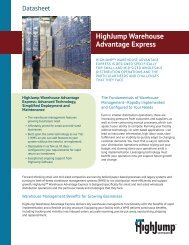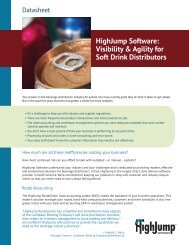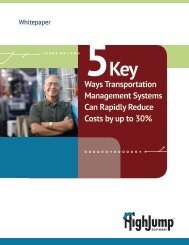Small-Business Warehouse Management Systems - HighJump ...
Small-Business Warehouse Management Systems - HighJump ...
Small-Business Warehouse Management Systems - HighJump ...
Create successful ePaper yourself
Turn your PDF publications into a flip-book with our unique Google optimized e-Paper software.
Whitepaper<br />
Debunking<br />
the Top Eight Myths<br />
Surrounding<br />
<strong>Small</strong>-<strong>Business</strong><br />
<strong>Warehouse</strong><br />
<strong>Management</strong><br />
<strong>Systems</strong>
Debunking the Top Eight Myths Surrounding <strong>Small</strong>-<strong>Business</strong><br />
<strong>Warehouse</strong> <strong>Management</strong> <strong>Systems</strong><br />
There are many misconceptions<br />
that prevent small businesses<br />
from attaining the benefits of<br />
a best-of-breed warehouse<br />
management system.<br />
Introduction<br />
The era of manual warehouse operations is drawing to a close—<br />
with good reason. No matter how efficient your employees are,<br />
managing space and maintaining inventory with ad-hoc<br />
spreadsheets, paper-based operations, or legacy systems doesn’t<br />
provide the accuracy, or visibility, into the supply chain that your<br />
managers need to succeed. Today, as businesses of all sizes grow<br />
in sophistication, they are turning to best-of-breed warehouse<br />
management systems (WMS) in an effort to reduce costs and<br />
boost productivity in the face of increased globalization, regulation<br />
and competition.<br />
Myth 1: A warehouse management<br />
system will take months, even up to a<br />
year, to install, and cost hundreds of<br />
thousands of dollars in consulting and<br />
service fees.<br />
Reality: Not so. While some larger WMS implementations can<br />
take up to a year and require hefty customization with corresponding<br />
consulting fees, there are WMS applications specifically<br />
designed for smaller businesses. In fact, with the right<br />
best practice-based implementation, deployment can be achieved<br />
within 45 business days, including quickly mapping your<br />
physical warehouse to your logical warehouse. You just need a<br />
software vendor with the right solution, technology, and supply<br />
chain experience. Software vendors lacking a demonstrated<br />
implementation methodology often see delivery timeframes slip,<br />
thus raising the implementation cost.<br />
For too long, leading warehouse management systems have<br />
seemingly been within the reach of only large third-party<br />
distributors, or national and international manufacturers and<br />
retailers. No more. To stay competitive, mid-sized and small<br />
businesses increasingly are turning to best-of-breed warehouse<br />
management systems that effectively reduce costs and streamline<br />
daily operations, enabling even the smallest companies to adapt<br />
quickly to changing market demands.<br />
In fact, research firm ARC Advisory Group’s recently published<br />
report, <strong>Warehouse</strong> <strong>Management</strong> <strong>Systems</strong> Worldwide Outlook 1 ,<br />
predicts that the worldwide market for WMS is expected to grow<br />
at a 4.8% annual rate, while their projection for adoption of<br />
these systems among Tier 3 companies is anticipated to grow at<br />
a much brisker rate of 8.2%. Yet, the reality is that many small<br />
businesses still believe warehouse management systems are<br />
too expensive for their budgets or won’t provide the benefits<br />
they need to thrive. This may have been true as recently as a few<br />
years ago, but as this report will show, WMS for small distributors<br />
are now not only within reach and affordable, but they are also<br />
a competitive necessity.<br />
<strong>Warehouse</strong> <strong>Management</strong> <strong>Systems</strong>:<br />
The Operational Benefits for <strong>Small</strong><br />
<strong>Business</strong>es<br />
• Improve productivity<br />
• Achieve up to 99+% accuracy<br />
• Increase on-time shipments and fill rates<br />
• Optimize warehouse space<br />
• Slash shrinkage and spoilage<br />
• Boost customer loyalty by consistently meeting or<br />
exceeding expectations<br />
1 ARC Advisory Group report: “<strong>Warehouse</strong> <strong>Management</strong> <strong>Systems</strong> Worldwide Outlook.” May 2, 2007.<br />
2
Debunking the Top Eight Myths Surrounding <strong>Small</strong>-<strong>Business</strong><br />
<strong>Warehouse</strong> <strong>Management</strong> <strong>Systems</strong><br />
Myth 2: Any WMS that fits our business<br />
now will be too small for us in a couple<br />
of years.<br />
Reality: Not always. The trick is to choose the software vendor<br />
that can provide you all of the functionality you need today,<br />
along with an underlying technology platform that enables<br />
future growth. In this way, your WMS should not require extensive<br />
new installations or customization. The vendor you choose<br />
should be able to provide a straightforward upgrade path to add<br />
new functionality or additional modules, such as slotting, labor,<br />
yard and transportation management systems—without an<br />
entirely new deployment.<br />
Myth 3: WMS software is too expensive<br />
for small businesses.<br />
Reality: For less than the annual salary of a skilled programmer,<br />
WMS solutions are available that provide everything you need<br />
to improve the management of inbound orders, receiving,<br />
put-away, picking, packing/shipping, replenishment, inventory<br />
control and comprehensive reporting. Some software vendors<br />
also provide flexible, even subscription-based, pricing plans.<br />
This means nearly any company can afford a WMS that will<br />
help it remain flexible, competitive and profitable.<br />
In addition, WMS technology is now available in a cloud delivery<br />
model from some providers, offering a lower cost, reduced risk<br />
option. Your WMS vendor hosts the software application and<br />
hardware infrastructure for you and there is no hardware to<br />
purchase or maintain, patches and upgrades are done automatically,<br />
implementation is dramatically simplified, no capital<br />
expenditure is required and there is less risk for you.<br />
Myth 4: Any vendor that can give me<br />
a decently priced WMS will be out of<br />
business in a few years.<br />
Reality: There’s no doubt that you have to be selective when<br />
choosing your software partners. That’s why it’s vital that you<br />
pick a vendor with not only the right solution set and supply<br />
chain experience, but one that also has the financial viability<br />
to be there for the long haul.<br />
Myth 5: A low, up-front cost for a WMS<br />
will automatically provide a lower total<br />
cost of ownership over the long term.<br />
Reality: An unusually low price tag on a WMS should set off a<br />
warning signal for prospective buyers. Some WMS vendors may<br />
choose to drop their asking price to an attractively low number<br />
in order to win your business because they anticipate a much<br />
higher cost of implementation services once the project is<br />
underway. If the product actually is as inexpensive as the price<br />
tag indicates, it is reasonable to wonder how much money the<br />
vendor can invest in R&D to continually improve your product<br />
over time. Make sure you are not buying a legacy product that<br />
has limited future viability.<br />
Myth 6: I’m too small to reap any<br />
benefits from a WMS.<br />
Reality: Virtually any company, no matter how small, will save<br />
on labor, improve inventory management, attain more accurate<br />
shipments, improve space allocation, and notice increased<br />
customer satisfaction. Because a WMS will give you a highly<br />
accurate picture of your inventory—and increase overall<br />
visibility—a WMS should significantly reduce the amount of<br />
time employees will have to spend figuring out what tasks and<br />
actions they need to perform next. And your WMS will reduce<br />
paper-driven processes, so your employees will spend less time<br />
moving paper, and more time shipping orders.<br />
While there is no set timeframe in which you can expect an ROI<br />
without a detailed cost/benefit analysis, the typical time for<br />
return on investment will be 6 to 18 months, depending of the<br />
effectiveness of the WMS you purchase and the current details<br />
of your operations.<br />
3
Debunking the Top Eight Myths Surrounding <strong>Small</strong>-<strong>Business</strong><br />
<strong>Warehouse</strong> <strong>Management</strong> <strong>Systems</strong><br />
Myth 7: I don’t need a best-of-breed<br />
WMS; my homegrown system already<br />
works and gets the job done.<br />
Reality: Could be. But how much is the ongoing maintenance<br />
and customization of this application really costing your company?<br />
Over time, as developers leave (along with their knowledge of<br />
the system) custom-developed applications become increasingly<br />
difficult to budget for and support. The systems get more costly<br />
to maintain as they become less adaptable to changing business<br />
requirements, and each adaptation grows more expensive as<br />
documentation ages and troubleshooting becomes more<br />
challenging. The reality is that the right WMS should be flexible,<br />
adaptable to changing business and market conditions, and<br />
cost less to support.<br />
Myth 8: Training costs will be too high.<br />
Reality: The right WMS should be designed to simplify your<br />
warehouse operations, not complicate them. An intuitive and<br />
well-built application should make receiving, picking, shipping<br />
and other basic warehouse operations flow smoothly without<br />
requiring extensive training. And over the long term—because all<br />
of the intelligence of your warehouse operations will rest within<br />
the system—your business will flow more effectively even in the<br />
event of employee turnover. Another aspect to consider is seasonal<br />
employment. If you increase head count during certain periods<br />
of the year, a strong WMS will direct and control the operations<br />
and enable these temporary workers to get up and running more<br />
quickly than before.<br />
<strong>Warehouse</strong> <strong>Management</strong> <strong>Systems</strong><br />
Clearly Benefit <strong>Small</strong> <strong>Business</strong>es<br />
Now you have it. It’s clear that a WMS designed for small<br />
businesses is affordable and rapidly deployable. Your WMS should<br />
provide continuous tracking and visibility into your operation,<br />
as well as improve productivity, increase accuracy up to 99+%,<br />
reduce inventory shrinkage, and improve customer loyalty with<br />
more on-time shipments.<br />
What questions should I ask potential<br />
WMS vendors?<br />
Some WMS buyers make the mistake of focusing too much on the<br />
software, and don’t look closely enough at the vendor backing it.<br />
So be sure that the vendor brings strong financial health, ongoing<br />
product support, and long-term viability. Also, check to see if the<br />
vendor has a solid base of reference customers, training and<br />
user conferences. If the vendor has an active user community,<br />
it’s a great sign that you’ll have a healthy partnership.<br />
When evaluating WMS vendors, be sure to look at:<br />
• Their long-term financial and business stability.<br />
• Does the vendor offer both on-premise and cloud-based<br />
deployment options?<br />
• The upgrade path for their WMS as your business grows<br />
or needs change. Does the vendor provide a straightforward<br />
upgrade path, or will you require an entirely new installation,<br />
product or platform?<br />
• Is it possible to add specific supply chain modules, such<br />
as yard, transportation or labor management?<br />
• Does the vendor bring domain expertise and experience<br />
helping companies that are similarly sized and in the<br />
same industry as your business?<br />
Conclusion<br />
The days when leading warehouse management systems were<br />
available only to large, top-tier retailers and distributors are<br />
over. Many small distributors are now turning to best-of-breed<br />
warehouse management systems to attain the cost reduction and<br />
streamlined operations required to respond to dynamic market<br />
demands and maintain competitive advantage.<br />
Since WMS and vendors vary greatly, it’s crucial that you examine<br />
them carefully, invest wisely and pick a software vendor with<br />
long-term viability, as well as an application that won’t require<br />
you to purchase more functionality than you need today, yet<br />
provide a straightforward and flexible upgrade path in the future.<br />
© 2011 <strong>HighJump</strong> Software Inc. All rights reserved. <strong>HighJump</strong> is a trademark of <strong>HighJump</strong> Software Inc.<br />
4
















